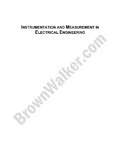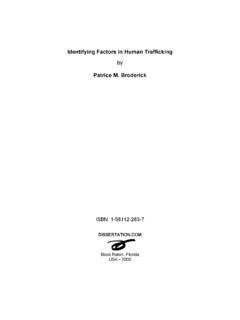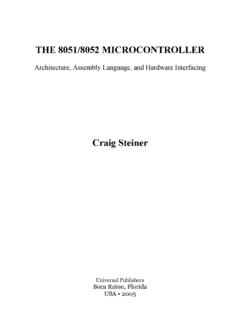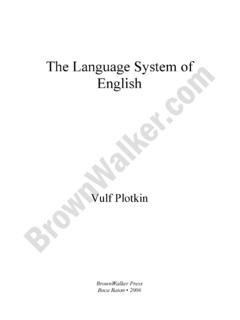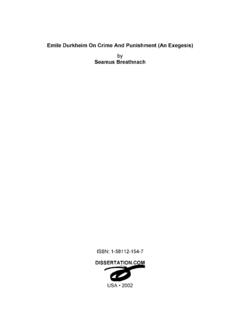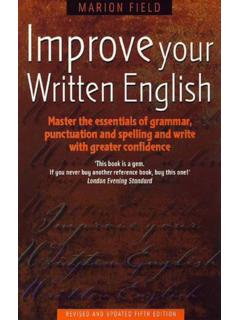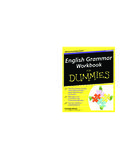Transcription of Business English and Conversation - Universal-Publishers.com
1 Business English and Conversation for the EFL-ESL Classroom A combination textbook-workbook on Business English , Conversation and Correspondence for students of EFL ( English as a Foreign Language) or ESL ( English as a Second Language). Armando Aceituno M. 1. Business English and Conversation for the EFL-ESL Classroom Copyright 2000 Armando Aceituno M. All rights reserved. No part of this book may be reproduced in any form or by any means, electronic or mechanical, including photocopying, or by any system of information, storage or retrieval without written permission from the author. Layout : Black Angel Enterprises Editing and Proofreading: Servitec 1st published by Universal USA 2000. ISBN: 1-58112-712-X. INTRODUCTION. Recent developments in technology, plus the world of globaliza- tion have caused our classrooms to change substantially.
2 Nowadays, the teacher needs to understand a lot more about technology than he/she used to. It is not enough to be fluent in the English language to be able to teach it. If you do not possess the skills that this new world and new millenium require, you will be hopelessly left behind. This Business English and Conversation book was created thinking about the specific needs of the ESL-EFL teachers and their students. It is meant to serve as a useful guide to aid in the devel- opment of the fluency needed in and out of the classroom. Because of the grammar and correspondence requirements of our world, this modernized and up-to-date series offers these characteristics: General exercises which help the students develop all four basic skills: Listening Speaking Reading Writing Grammar practice and reviews A correspondence section with varied samples of the common Business documents.
3 Business , Internet, data processing and general vo- cabulary Optional Conversation , writing and spelling exercises General reviews and recycling of all material. As is the case with most other works of this nature, this book is as complete as humanly possible, but it can still use your helpful suggestions on how to make it better. Please send your comments or questions either to or Armando Aceituno M. 3. ABOUT THIS BOOK. Some reference works define Business English as the correct and proper way to use the language. But how can you use the language properly unless you know it well from its foundation? Think of it this way: When you build a house, what do you build first? Do you install the roof before the foundation? Never. You lay the foundation first. That's also the way to build correct habits on using the lan- guage, from its very own foundation.
4 This book does exactly that. It begins from the founda- tions of language: the parts of speech. It goes into each and every one of them in a brief yet comprehensive way, from the simple ones like nouns to the more complex ones like auxiliary verbs. Then it goes into using those parts of speech correctly in sentences. Once you know how to use the parts of speech in sen- tences, we will go into some important items such as tag questions, conditions with if, capitalization, and punctua- tion marks. You will then be ready to start building para- graphs that make sense and accomplish their objective. Afterwards, you can go into making effective Business documents. Furthermore, as you progress by doing the required and optional exercises in the book, you will be putting your con- versational skills to work.
5 The section on correspondence also begins from the simple parts of the letter, then goes into all the differ- ent styles and types of letters. Samples of each type Business English and Conversation - Armando Aceituno M. of letter are included, as well as exercises to help you put your writing skills at work. How can you best use the book to your advantage? It depends on your own situation. Therefore, carefully analyze your needs before you begin, then adapt the book to suit those needs, not the other way around. Busi- ness English and Conversation has been developed based on past experiences with groups of all types and levels, but it is up to you to use it in the way that you best think fit. What we did not include: Pronunciation: The English language pronunciation cannot be written, unless we use the international symbols which have been designed and created specifically for that purpose.
6 This is because English has more than 40 recognized sounds, many of which do not exist in other languages. Therefore, it is extremely difficult to write the pronunciation even of simple words like CUT. The sound of the letter U in CUT. is pronounced in a way which cannot be accurately represented with the basic alphabet. In addition to this, it is a known fact that good pronunciation can best be learned by listening to the teacher and other speakers of the language. 5. About the author Armando Aceituno M. has been teaching ESL. and EFL for over twenty years. A textbook author, teacher trainer, lecturer, novelist, poet, playwright and screenwright, he has published more than twenty five books for teachers and students of ESL and EFL. His textbooks have been used at hundreds of schools located in several areas of his native Latin America.
7 He has also published poetry, short stories, and manuals on diverse computer programs. His EFL-ESL works include: Bilingual Dictionary - English /Spanish Better English Today, Books 1, 2 and 3. TOEFL Workshop - A Practical Approach Commercial English and Correspondence Freedom, Books 1, 2 and 3. English Magic, Books 1-6. English Power, Books 1, 2 and 3. English Control, Books 1, 2 and 3. English Literature for the EFL-ESL classroom EFL-ESL Teachers' Handbook, under production Business English and Conversation - Armando Aceituno M. Table of Contents PART I GRAMMAR. Page: Introduction To The Parts Of Speech 10. CHAPTER 1 Nouns 12. Proper And Common; Masculine, Feminine and Neutral; Nouns that Specify Number; Plural Versus Singular; Indefinite Article Review; Mass Nouns and Count Nouns; Article The.
8 CHAPTER 2 Pronouns and Adjectives 29. Pronouns : Subject, Object, Reflexive, Emphatic, Interrogative, Relative, Reciprocal Adjectives : Descriptive, Limiting, Demonstrative, Proper, Possessive; Comparison using Adjectives GENERAL PRACTICE 43. CHAPTER 3 A Few Not-so-Little Things 47. Adverbs : Modifying Verbs, Adjectives or other Adverbs;. Comparison; Other Adverbs and Expressions of Time Prepositions : Common Prepositions;Special Situations Conjunctions: Coordinate, Correlative, Subordinate Interjections; Showing Possession with Nouns, Pronouns or Adjectives GENERAL PRACTICE 63. CHAPTER 4 Verbs 67. Adding S or ES; Action vs. Linking; Regular vs. Irregular;. Transitive vs. Intransitive; Auxiliary Verbs Problem Verbs: Say and Tell; Borrow and Lend; Earn, Win and Pass; Remember and Remind; Hope, Wait and Expect.
9 Do and Make; Get and Take Common Mistakes: Problems with Pronouns; Nonexistent Words and Contractions; Language Interference; Incorrect Use of Plurals and/or Verbs; Had Better; Uses of IT and ING;. Spelling: Adding ING to the verb GENERAL PRACTICE 91. CHAPTER 5 Other Structures Part I 93. Common Contractions; Tag Questions; Embedded Questions; Active Voice and Passive Voice; Conditions with IF; Reported Speech;. 7. Page: CHAPTER 6 Other Structures - Part II 111. Two- verb Structures; Causatives; Capitalization GENERAL PRACTICE 119. CHAPTER 7 - Correct Punctuation 122. Period, Comma, Semicolon, Colon, Ellipses, Hyphen, Dash, Question Mark, Exclamation Point, Quotation Marks, Apostrophe CHAPTER 8 - Effective Communication 133. Purpose; Guidelines; Phrases, Fragments and Sentences.
10 Run-on Sentences; Comma Splice; Paragraphs PART II CORRESPONDENCE. CHAPTER 9 Parts Of The Letter 151. Letterhead, Date Line, Typed Heading, Inside Address, Outside Address, Salutation, Body, Continuation Line, Closing, Signature, Initials, Enclosures, Carbon Copies, Postscript Letter Styles Punctuation Styles CHAPTER 10 Types of Letters 162. Letter of Inquiry, Letter of Reply, Order Letter, Letter of Acknowledgment, Collection Letter, Letter of Remittance (Transmittal), Claim Letter, Adjustment Letter, Interoffice Memorandum, Letter Of Reference, Telegram, R sum . APPENDIX A Useful Business Phrases 177. APPENDIX B Regular Verbs 179. APPENDIX C Irregular Verbs 182. Business English and Conversation - Armando Aceituno M. PART I. Structure and Conversation 9. PARTS OF.
